Last Updated on February 9, 2022 by Chris and Lindsay
It is important to know the Dalton Highway road conditions if you plan to safely drive any portion of the road.
The Dalton Highway itself is a brutal 415-mile mixture of road conditions. The road is minimally maintained to accommodate semi-trucks. Yet every year thousands of tourists attempt to drive the Dalton Highway. Most want to visit the Arctic Ocean at the road’s terminus in Deadhorse, Alaska.
Download the ROAD CONDITIONS on the DALTON HIGHWAY pdf
We were such tourists that successfully completed the drive during the summer of 2018. But we had trouble with our planning. Despite all of our research, we could find nothing that described the actual Dalton Highway road conditions.
We went into the drive almost entirely blind to the actual dangers of the highway. This nearly cost us on our return trip!
The Milepost offers a great reference so that you know the general sites and fuel locations along the way. Still, we drove the entire 830-miles roundtrip without knowing anything about the Dalton Highway road conditions.
Whether you drive a motorcycle, car or truck, RV or even bicycle you should know the road conditions prior to leaving Fairbanks.
DALTON HIGHWAY ROAD CONDITIONS
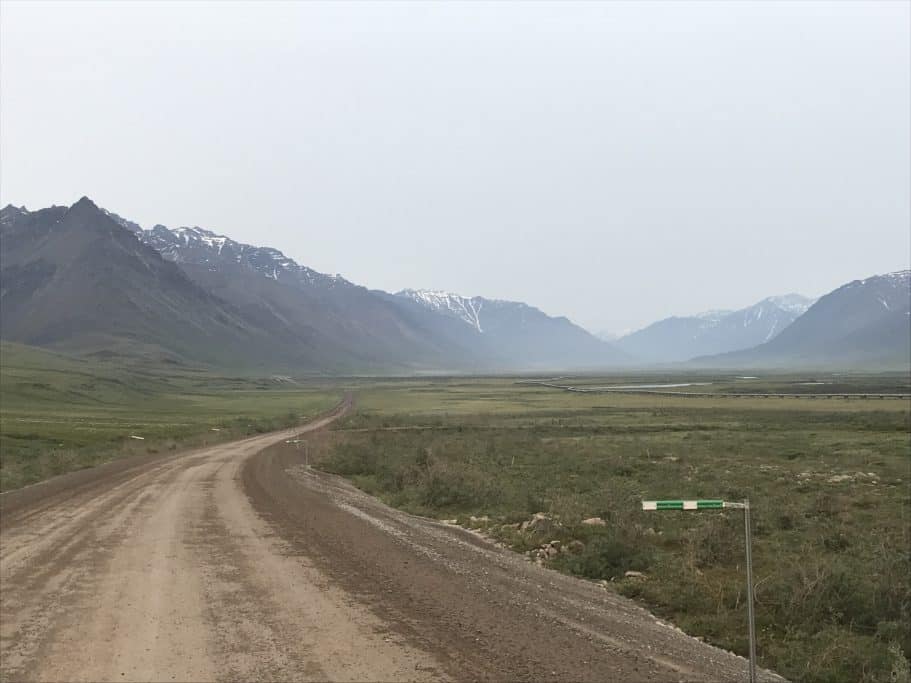
We advise that you download and print the ROAD CONDITIONS of the DALTON HIGHWAY PDF for a mile-by-mile record of the Dalton Highway road conditions.
NOTES:
Dirt/Gravel is maintained in periodic portions by adding water and then grading it with a motor grader. Thus the actual conditions of the Dirt/Gravel vary on a DAILY BASIS.
“Frost Heaves” are bumpy portions of PAVED roads. We found it easier to drive on dirt/gravel than on paved roads with frost heaves.
| MILE MARKERS | ROAD CONDITIONS | COMMENTS |
| 0 – 17 | Dirt/Gravel | Steep grades in both directions |
| 17 – 18 | Gravel/Paved | |
| 18 – 22 | Paved | Significant road damage |
| 22 – 36 | Dirt/Gravel | |
| 36 – 48 | Paved | LOTS of frost heaves |
| 48 – 89 | Dirt/Gravel | |
| 89 – 109 | Paved | TERRIBLE, potholes, stretches of road that turns to dirt/disappears |
| 109 – 110 | Dirt/Gravel | |
| *** 115 | ARCTIC CIRCLE TURNOFF | Photo Opportunity |
| 110 – 135 | Paved | Potholes NOT FILLED |
| 135 – 143 | Paved | Potholes mostly FILLED |
| 143 – 158 | Dirt/Gravel | |
| 158 – 165 | Paved | OK, with some frost heaves |
| 165 – 175 | Paved | |
| *** 175 | COLDFOOT | Best place for fuel and coffee! |
| 175 – 210 | Paved | BEST stretch of highway! You can easily and safely drive up to speed |
| 210 – 340 | Dirt/Gravel | Hard packed dirt with loose gravel |
| *** 245 | ATIGAN PASS | Highest elevation for drive |
| 340 – 347 | Paved | Higher quality pavement |
| 347 – 359 | Dirt/Gravel | Bumpy, frost heaves |
| 359 – 363 | Paved | Decent with few potholes or bumps |
| 363 – 370 | Dirt/Gravel | **CONSTRUCTION AT TIME OF WRITING
(NOTE: This is where we had our blowout on our return trip. One large, sharp piece of gravel punctured our tire.)
|
| 370 – 375 | Dirt/Gravel | Hard-packed, loose gravel with some washboard and large gravel |
| 375 – 380 | Dirt/Gravel | Elevated road, hard-packed, occasional bumps, lower quality |
| 380 – 415 | Dirt/Gravel | Elevated road, hard-packed, loose gravel, large gravel at times |
| 415 | Deadhorse | YOU MADE IT!! |
The Reward of the Dalton Highway
The reward for completing the drive of the Dalton Highway is that you achieve what very few tourists do. You can look back on the journey and count the amazing scenery and animals among your victories. But you can also cross off driving one of the world’s most dangerous roads!
If you are still unsure whether you can complete the drive check out our Dalton Highway DrivingSafety Tips. By following these tips we completed the 830-mile roundtrip with minimal concern!
Dalton Highway Driving Safety Tips
The following Dalton Highway driving tips will help you make the most out of your journey toward the Arctic Ocean.
Prior to our drive, we found quite a bit of information about the highlights and stops along the highway. But we felt inadequately prepared for the actual drive itself. We had no idea what to expect of the road conditions or how to safely navigate the treacherous road.
As such we have compiled a list of Dalton Highway Driving Tips that will allow you to find pleasure on the road while remaining safe and respectful of other drivers on the highway. The road itself will lead you through desolation and leave you feeling entirely alone at times.
But you are never entirely alone on the Dalton Highway! So remember this and follow our advice and you can make your journey (and that of others) safe and enjoyable!
You will find that these Dalton Highway Driving Tips are more “you-centered.” In other words, these tips will help you handle your own vehicle better on the road. Please be sure to read about tips on how to interact with other drivers in our Dalton Highway Safety Driving Tips section below.
Views along the Dalton Highway are spectacular.
1. Reset your trip meter at the start of your trip.
When leaving Fairbanks there is a sign indicating you are entering the Dalton Highway. In Deadhorse, the highway actually begins at a T junction where the Dalton Highway meets Lake Colleen.
Reset your Trip Meter in both locations such that you can use the Road Condition markers and the Milepost Quick Reference Log so you can know what to expect as you drive.
NOTE: The famous “Dalton Highway Sign” is actually just over 1 mile into the highway so if you reset your trip meter there then you should account for that small discrepancy!
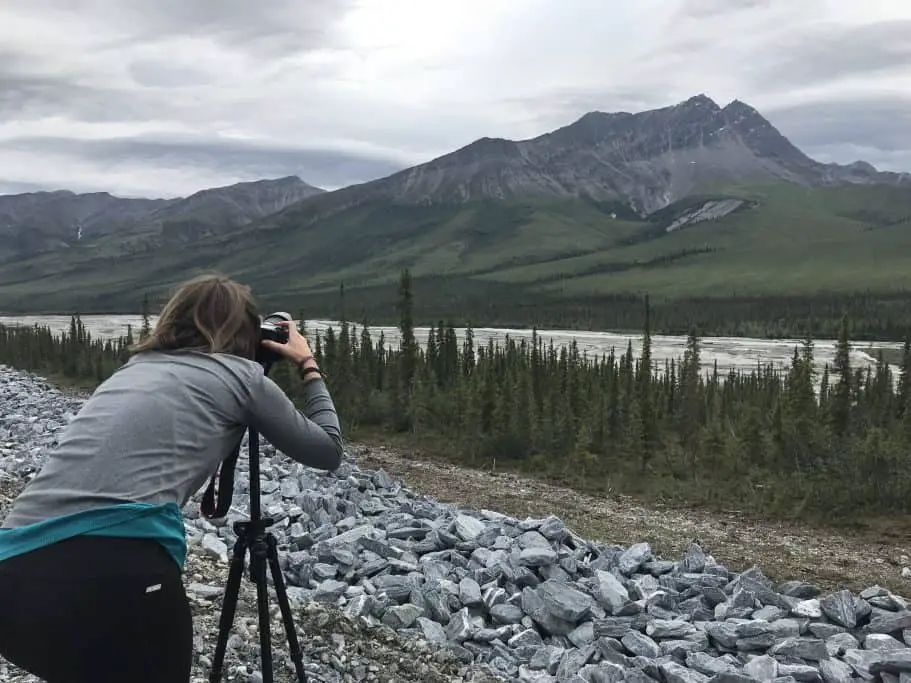
2. Have your Road Conditions markers and Milepost Quick Reference Log handy
Be prepared to have these resources OFFLINE. You will NOT have cellular service on the Dalton Highway. We wrote out our plan on a scratch sheet of notebook paper so that we could anticipate when we would cross certain milestones.
With the addition of our Road Conditions markers you should meet very little if any, surprises… as long as you have them quickly available offline. You can take a screenshot on your phone or tablet or handwrite them.
But have them handy to keep you safe and aware of upcoming points of interest.

3. Know your fuel range and plan accordingly.
The easiest fuel stop for us was Coldfoot. Coldfoot is approximately 260 miles from Fairbanks and 240 miles from Deadhorse. Both of these distances were within range for our truck.
However, we did fuel up in Deadhorse as well so that we could make both of these distances. (Fuel in Deadhorse is expensive, but it is better to pay more for fuel than to run out on the Dalton Highway!).
We used Coldfoot as our “midway point” and also fueled up on caffeine while we were there.
4. Plan your trip ahead of time.
Always be prepared to adjust your plans, of course. But if you plan to take two days to drive the Dalton Highway each way, then have an idea of approximately how far you want to go each day.
Following Tip #2 and Tip #6 will allow you the flexibility to cover a certain amount of distance while also finding a safe place to rest. Be sure to stock up on fuel (Tip #3) and other items as needed along the way.
NOTE: This drive looks different on paper if you are riding a motorcycle vs an RV vs a car/truck vs a bicycle. Your plans will be different and your needs will be met differently.
For example, in our truck camper, we are always stocked well enough to live for 2-3 weeks on our own. But if you are riding a motorcycle or bicycle with limited storage it is important for you to know where you can expect a hot meal or to purchase groceries.
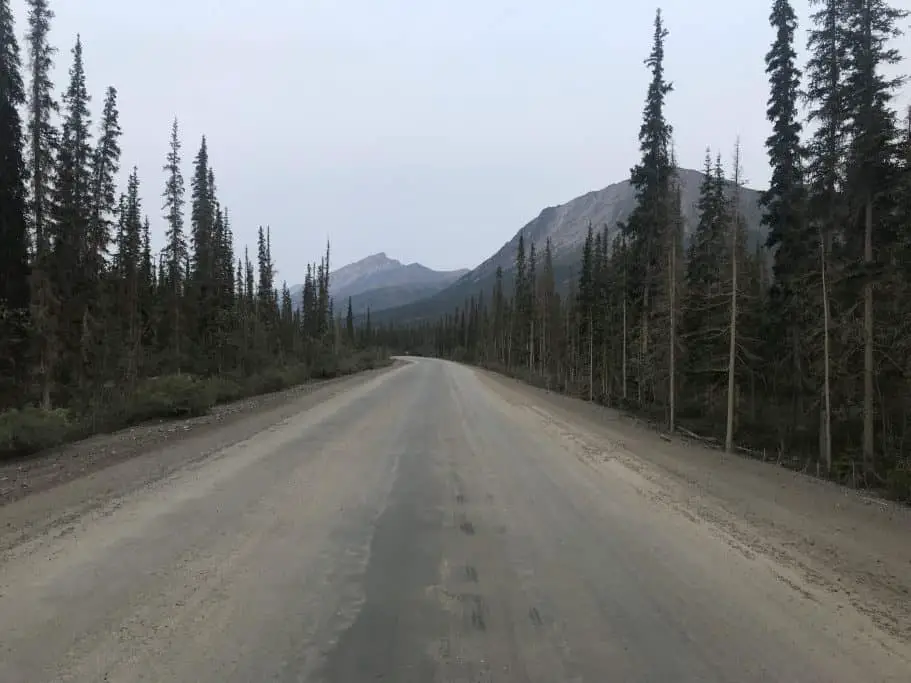
5. Be aware of everything.
This should be Tip #1 – 10. But as good of a driver as you are back home, be that much better on the Dalton Highway. Road Conditions can change instantly.
You might be up to speed on one stretch of the road and have to immediately stop for a string of potholes in another. Trucks will approach you from in front or the rear and fly past you as if you did not exist.
And, as cute as caribou, moose and musk ox are, they can cause big-time issues if you hit one (or turn suddenly to avoid hitting one!). Be aware constantly!
6. Rest stops are plentiful.
We wish we knew how abundant rest stops were before we started to drive the Dalton Highway. We anticipated having to cover long distances between stops for the evening.
However, you can pull off in so many places to rest. Just do so safely. Regardless of how badly you might need to use the restroom or stretch your legs, drive further until you reach a pullout. There will be one.
We didn’t even bother to mark them all in our Road Condition guide because there are so many. Whether you race to Deadhorse and back as we did, or you take two weeks in each direction, know that there are plenty of places to pull over and rest.
Just don’t expect them to be quiet! Trucks and other vehicles drive the Dalton Highway at all hours of the day and night. You will hear them when they pass.
7. Bridges are usually a sign to slow down.
We found that some of the most consistently inconsistent parts of any road (paved or otherwise) were both before and after a bridge. As such, we advise that you slow prior to the transition between the road and bridge.
There are a few places with nice, gradual transitions between the road and bridge. But many of the bridges, especially the one crossing the Yukon River, are wooden and that necessitates a different grade between the bridge and the highway.
Resetting your trip meter and knowing when to use overdrive are two helpful tips for driving the Dalton Highway.
8. Overdrive can be the enemy.
If you are driving a larger rig it is likely you won’t need overdrive at all. Between the constantly changing road conditions and the steep grades both uphill and downhill, keeping your engine purring at slightly higher revolutions is likely better for it on the long haul than burning out the transmission.
Even using overdrive and lower gears to go both up and downhill there were a few instances where we had to pull over to let our transmission cool down.
Our overdrive was only efficient at 55 – 60 mph so only in one 35 mile stretch (between Mile 175 and 210, north of Coldfoot) did we consistently use it.
9. Lower gears can be your friend.
When going down steep grades, taking off overdrive will also allow your engine to help you brake. Depending on the size/weight of your vehicle, this can allow you tremendous savings in the wear of your brakes.
While we still needed to tap the brakes from time to time on steep descents, in many cases our third or even second gear were able to slow us down enough to safely cruise downhill.
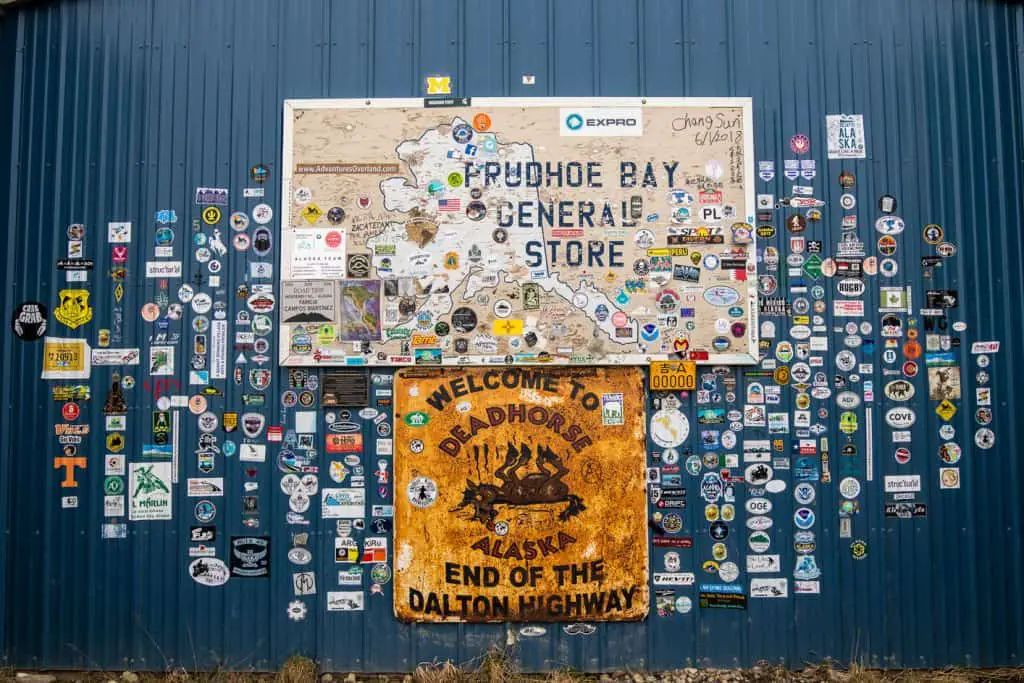
Enjoy the Drive!
Driving the Dalton Highway is incredibly rewarding! From the wildlife you will see to the spectacular, desolate landscapes the Dalton Highway is worth the drive. However, it is best to always be prepared for the harsh conditions of the road.
If you follow these Dalton Highway Driving Tips and know where to expect road conditions to change then you will have a safer, more enjoyable drive to the top of the world!
Dalton Highway Driving Safety Tips
We have divided our suggestions into two general types. One we call “Rules” and the other is “Tips.”
“Rules” are not necessarily legal laws. We just suggest that you treat them as absolutes when you drive. These will protect you and your passengers, but also provide respect and courtesy for those people who drive the Dalton Highway for work.
“Tips” are actions that will make your drive safer and more enjoyable. You don’t have to heed these either. But having safely completed following these guidelines we think you’ll benefit from our experience.
NOTE: – We did have a tire blow out and we did stop for several other people who experienced mechanical troubles on the highway. So we feel we learned enough to offer sound and reasonable advice to make your drive better!
Dalton Highway Driving “Rules”
1. Let approaching big rig (semi-trucks) pass from in front.
If you are not on a clearly marked divided highway (paved), move over to the side and slow or stop to let them pass.
NOTE: The faster you go past them on dirt roads the greater the chance they will kick gravel into your windshield! It’s better to come to a complete stop and let them pass than to end up with a cracked windshield!
2. Let approaching big rig (semi-trucks) pass from behind.
Check your rearview and side-view mirrors constantly to ensure that you are not holding up traffic behind. If you have a big rig behind you, put on your right turn blinker and move over to the side immediately.
This is a tourist trip for you. For the drivers, it is their job. Please respect that!
3. Let all faster traffic pass.
People drive at all sorts of speeds on the Dalton Highway. You could be up to speed or even over the speed limit and you might have a line of traffic behind you.
Whether you are sauntering along enjoying the scenery or traveling at breakneck speed, let all faster traffic pass you from behind.

4. Try to stay up to speed.
The speed limit for most of the Dalton Highway is 50 miles per hour. This is both for safety and efficiency.
While dirt roads seem daunting, especially to smaller vehicles or those carrying large loads, reaching 50 mph will actually help you safely navigate the dirt roads. It will also keep you from holding up traffic behind you. And, did we mention, it will help you arrive at your destination sooner!
NOTE: Some stretches of the highway are deceptively dangerous. Check out Dalton Highway Road Conditions first and ALWAYS be aware of upcoming changes in the road.
5. Don’t be afraid to slow down.
A speed limit is a maximum speed for safety issued for the highway. You do not need to go the maximum speed on the Dalton Highway. In fact, we rarely made it up to speed due to the constantly changing road conditions.
So do not be afraid to slow down to a speed at which you feel safe and comfortable. However, note Rule #2 and Rule #3 and let all approaching traffic pass you.
6. Pick a lane, any lane.
Much of the Dalton Highway does not have clearly indicated lanes on the road. For most of the drive, you will be on your own in the middle of Alaskan nowhere. This enables you to “pick a lane, any lane” in which you feel safe.
However, use common sense and keep an eye both ahead and behind you so that you can return to the right lane when there is traffic.
7. Use emergency flashers (hazard lights) only when you are faced with an emergency.
If you stop to take a photo you should use one of the many pullouts. If no pullout is nearby and you still want your photo, pull to the right side as far as you can without going off the road.
However, do not put your emergency flashers on unless it is an emergency. Many drivers WILL stop to offer assistance when they see a vehicle with emergency flashers on. Please don’t waste their time if you do not have an emergency!

8. Be aware when stopping to take photos.
You will stop to take photos. You’ll likely stop a LOT to take photos. The scenery along the Dalton Highway is THAT beautiful! However, when stopping for a photo please pull off at a designated pullout or, if one is not available, pull completely off the main highway to the right.
NOTE: Traffic will still pass even when you are stopped. Be aware that a big rig traveling at 50 + mph will throw dust, rocks and mud at you if you are by the side of the road!
9. Stop for someone (everyone) on the side of the road.
The Dalton Highway is beautiful and for those of us brave enough to drive it in its entirety we are bound to run into trouble. Whether you have a tire blowout (which we had!) or you come across someone else with vehicle issues, it is a courteous and safe thing to stop and offer assistance.
It is very likely that the issue is under control. However, don’t expect cell service anywhere on the Dalton Highway (until about 15 miles from Deadhorse). So when a stranded driver might normally call someone for help, it is likely you are their first and last line of assistance.
Be prepared to carry the driver to the next populated area or to sit and wait with them until a truck or driver with a CB radio can stop and radio for assistance.
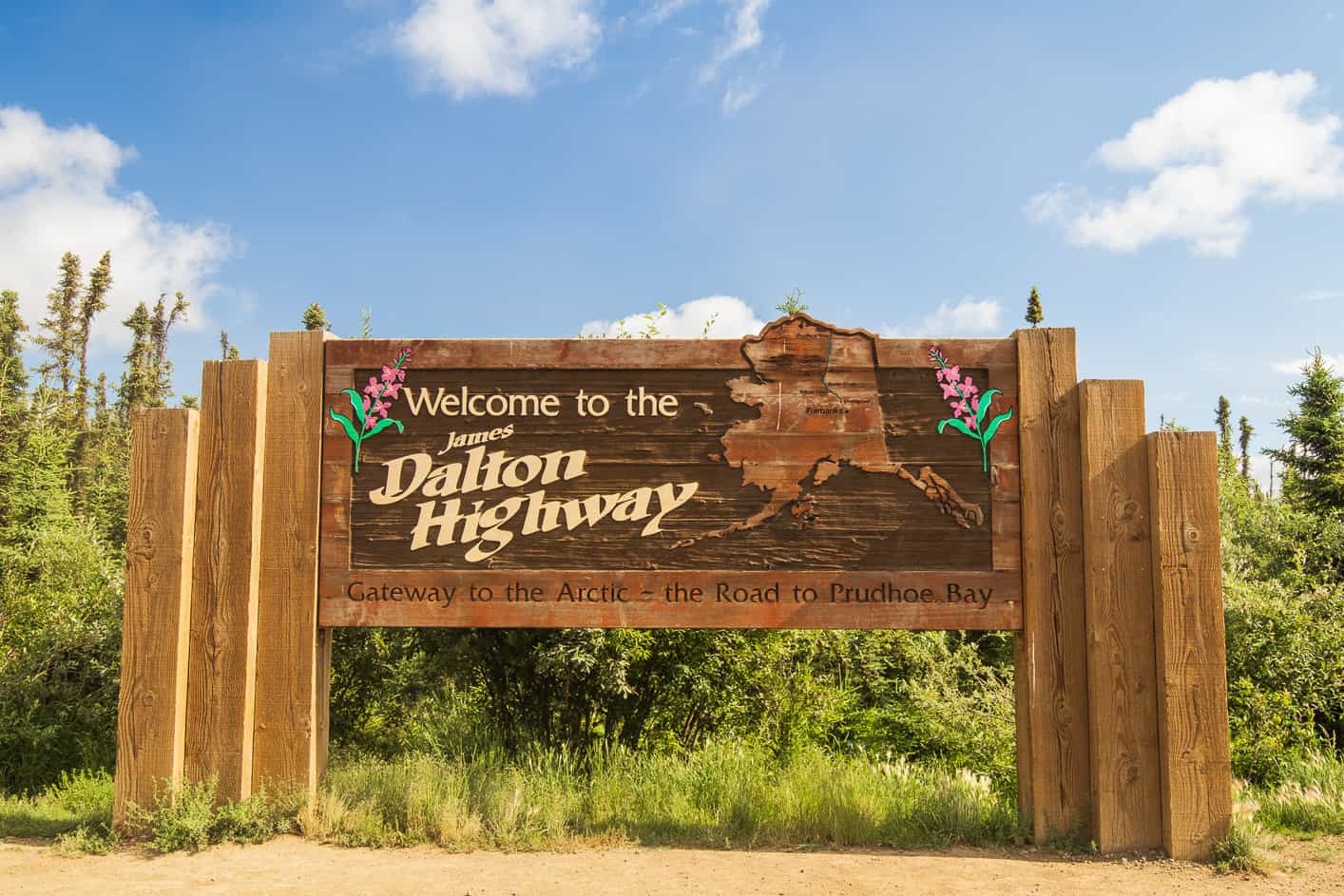
Comments are closed.